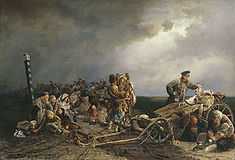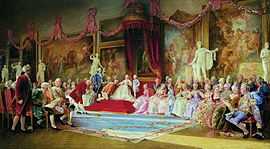Valery Jacobi
| Valery Jacobi | |
|---|---|
 | |
| Born |
May 15, 1834 Kazan Governorate |
| Died |
May 13, 1902 (aged 67) Nice |
Valery Ivanovich Jacobi (Russian: Валерий Иванович Якоби or Якобий; 15 May [O.S. 3May] 1834, Village Kudryakovo, Kazan Governorate, Russia - 13 May 1902, Nice, France) was a Russian painter[1] and an older brother of Pavel Jacobi (1842–1913), a notable revolutionary and ethnographer.[2][3]
Biography
Valery Jacobi was born to a family of an estate owner and started his education in the Kazan University, but broke his study to enlist in Russian Army[1] (Siberian Volunteer Corps[4]) during the Crimean War. In 1856 after retirement from the Army he decided to abandon his University study and pursue the artistic career instead.[1]
In 1856-1861 he studied at the Imperial Academy of Arts, receiving a small gold medal for his painting Serene holiday of a beggar (1860). In 1861 he paints his probably the most notable painting Prisoners Stopping Place. In 1861-1869 Jacobi travels to Europe by an Academy grant, visiting Germany, Switzerland, France and Italy.[1]
In 1870 Jacobi became one of the founding members of the Peredvizhniki art society. But in 1872 he was excluded for his failure to participate in a society exhibition[1] and the general disagreement with the ideals of the society.[4] Later he was considered a conservative, sceptical to the Peredvizhniki's ideas.
Jacobi was a member of the Imperial Academy of Arts since 1868, a professor since 1871, taught in the Academy in 1878-1889.[2] He lived mostly in Saint-Petersburg creating historical paintings like Jesters at the Court of Anna Ioanovna (1872), Ice Palace (1878), etc. His works were criticized as purely decorative, lacking substance.[4]
Jacobi died in Nice, France in 1902.
Works
-

Serene Holiday of a Beggar, 1860
-

The Prisoners Rest, 1861
-
.jpg)
Jesters at the Court of Empress Anna, 1872
-

Ice palace of Empress Anna, 1878
-

An Oriental Beauty, 1881
-

The Inauguration of the Academy of Arts, 1889
See also
| Wikimedia Commons has media related to Valery Jacobi. |
References
- ↑ 1.0 1.1 1.2 1.3 1.4 Valery Jacobi in Krugosvet Online Encyclopedia (Russian)
- ↑ 2.0 2.1 Valery Jacobi in Great Soviet Encyclopedia
- ↑ Pavel Jacobi in Great Soviet Encyclopedia
- ↑ 4.0 4.1 4.2 Valery Jacobi on Pointart library